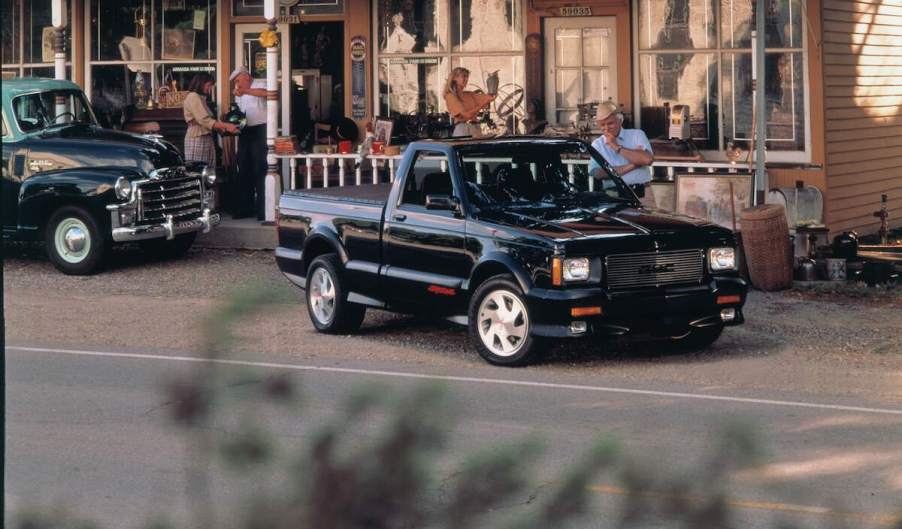
Here’s Why the 1991 GMC Syclone Had the Ground Clearance of a Sports Car
After seeing the impact of the Buick Grand National, GMC must have decided it wanted to build its own muscle car to blow the doors off Corvettes and Ferraris. The only problem was the closest thing GMC had to a sports car was the Sonoma, a small pickup truck sharing a platform with the Chevrolet S-10 and GMC Jimmy.
Game on.
GMC copied the Buick Grand National, from the turbocharged V6 engine down to the sinister black paint. To handle the power, it created an all-wheel-drive system and lowered the Sonama so it had the ground clearance of a sports car. For GMC, the Syclone was a cross between a moon shot and a hold-my-beer moment leading to a vehicle so outrageous we still talk about it.
The GMC Syclone was the 1st super-truck

Starting with a special version of the 4.3-liter V6, GMC added a turbocharger and cranked up the boost until the Syclone officially produced 280 hp. Rumor has it that the actual horsepower was well north of 300 and that GMC intentionally downplayed the number for insurance purposes. It’s also rumored the automaker didn’t want to upstage its sibling brand’s Corvette, which made 300 hp at the time.
If GMC’s engineers had any misgivings about upstaging the Vette’s power numbers, they had no qualms about embarrassing the sports car at the drag strip. The Syclone hit 60 mph in 4.3 seconds. That number is still quick today, but in 1991 it was in supercar territory and faster than just about everything else, including Ferraris, Porsches, and even the hottest Corvettes.
Unfortunately, that speed didn’t translate into Syclones flying out dealerships’ doors. In all, GMC produced 3,000 Syclone trucks, making it a bit of a flop sales-wise, even though the company never intended to sell it in large volumes. But the limited numbers and Radwood-era looks make it a classic hot rod today.
GMC lowered the original Syclone for better performance
The original Syclone had extremely low ground clearance for performance reasons. Its AWD system was developed to maximize grip and acceleration. But these designs came at a price.
The very things that made the Syclone incredibly fast made it a terrible pickup truck. It could barely haul 500 pounds in the bed, and the tow rating was 2,000 pounds. By comparison, the 1993 Ford F-150 Lightning could haul 745 pounds and tow 5,000 pounds, MotorTrend reports.
It might have been a good thing, too, that Ford’s payload capacities are higher because it would have been stuck carrying the Syclone’s water. Not only is the Lightning a bigger truck, but its 0-to-60-mph time was 7.2 seconds, almost three seconds slower than the smaller Syclone.
Can it go off-road?
If by “off-road,” you mean the parking lot of your local strip mall, then yes. But watch out for speed bumps.
Taking a Syclone off-roading would be like taking a Corvette rock climbing at Moab. The AWD is designed for performance, like Audi’s Quattro system, and is not intended for off-road use. In fact, GMC put warning labels in the owner’s manual and on the sun visor, cautioning owners from ever taking the Syclone off-road.
Even if you modified the Syclone, it would be a terrible off-roader. Lifting the ride height would hurt the performance, making the handling tipsy. The drivetrain doesn’t have a high-low range or locking differentials, and the engine’s powerband is not conducive to rock crawling. No matter what, off-roading a Syclone would be like roller skating on the sand at the beach. You just don’t want to do it.



